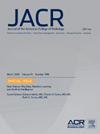Reducing Delays in MRIs Under Sedation and General Anesthesia Using Quality Improvement Tools
IF 4
3区 医学
Q1 RADIOLOGY, NUCLEAR MEDICINE & MEDICAL IMAGING
引用次数: 0
Abstract
Objective
Develop structured, quality improvement interventions to achieve a 15%-point reduction in MRIs performed under sedation or general anesthesia (GA) delayed more than 15 min within a 6-month period.
Methods
A prospective audit of MRIs under sedation or GA from January 2022 to June 2023 was conducted. A multidisciplinary team performed process mapping and root cause analysis for delays. Interventions were developed and implemented over four Plan, Do, Study, Act (PDSA) cycles, targeting workflow standardization, preadmission patient counseling, reinforcing adherence to scheduled scan times and written consent respectively. Delay times (compared with Kruskal-Wallis and Dunn’s tests), delays more than 15 min and delays of 60 min or more at baseline and after each PDSA cycle were recorded.
Results
In all, 627 MRIs under sedation or GA were analyzed, comprising 443 at baseline and 184 postimplementation. Of the 627, 556 (88.7%) scans were performed under sedation, 22 (3.5%) under monitored anesthesia care, and 49 (7.8%) under GA. At baseline, 71.6% (317 of 443) scans were delayed over 15 min and 28.2% (125 of 443) scans by 60 min or more, with a median delay of 30 min. Postimplementation, there was a 34.7%-point reduction in scans delayed more than 15 min, a 17.5%-point reduction in scans delayed by 60 min or more, and a reduction in median delay time by 15 min (P < .001).
Discussion
Structured interventions significantly reduced delays in MRIs under sedation and GA, potentially improving outcomes for both patients and providers. Key factors included a diversity of perspectives in the study team, continued stakeholder engagement and structured quality improvement tools including PDSA cycles.
利用质量改进工具减少镇静和全身麻醉下核磁共振成像的延迟。
目标:制定结构化的质量改进(QI)干预措施,使在镇静或全身麻醉(GA)下进行的核磁共振成像在 6 个月内延迟超过 15 分钟的情况减少 15%:方法:对 2022 年 1 月至 2023 年 6 月期间在镇静或全身麻醉下进行的核磁共振成像进行前瞻性审计。一个多学科团队对延误进行了流程规划和根本原因分析。在四个 "计划、实施、研究、行动"(PDSA)周期内制定并实施了干预措施,分别针对工作流程标准化、入院前患者咨询、加强遵守预定扫描时间和书面同意。记录了基线和每个 PDSA 周期后的延迟时间(通过 Kruskal-Wallis 和 Dunn 检验进行比较)、超过 15 分钟的延迟时间和 60 分钟或以上的延迟时间:分析了在镇静或 GA 状态下进行的 627 次核磁共振成像,其中基线时 443 次,实施后 184 次。556/627(88.7%)次扫描是在镇静状态下进行的,22/627(3.5%)次是在监测麻醉护理下进行的,49/627(7.8%)次是在GA下进行的。基线时,71.6%(317/443)的扫描延迟了 15 分钟以上,28.2%(125/443)的扫描延迟了 60 分钟或以上,中位延迟时间为 30 分钟。实施干预后,延迟 15 分钟以上的扫描减少了 34.7%,延迟 60 分钟或以上的扫描减少了 17.5%,延迟时间中位数减少了 15 分钟(P 讨论):结构化干预大大减少了镇静和 GA 下核磁共振成像的延迟,可能会改善患者和医疗服务提供者的治疗效果。关键因素包括研究团队的多元化观点、利益相关者的持续参与以及包括 PDSA 循环在内的结构化 QI 工具。
本文章由计算机程序翻译,如有差异,请以英文原文为准。
求助全文
约1分钟内获得全文
求助全文
来源期刊

Journal of the American College of Radiology
RADIOLOGY, NUCLEAR MEDICINE & MEDICAL IMAGING-
CiteScore
6.30
自引率
8.90%
发文量
312
审稿时长
34 days
期刊介绍:
The official journal of the American College of Radiology, JACR informs its readers of timely, pertinent, and important topics affecting the practice of diagnostic radiologists, interventional radiologists, medical physicists, and radiation oncologists. In so doing, JACR improves their practices and helps optimize their role in the health care system. By providing a forum for informative, well-written articles on health policy, clinical practice, practice management, data science, and education, JACR engages readers in a dialogue that ultimately benefits patient care.
 求助内容:
求助内容: 应助结果提醒方式:
应助结果提醒方式:


